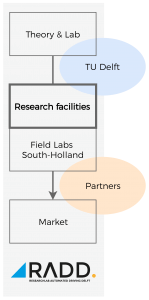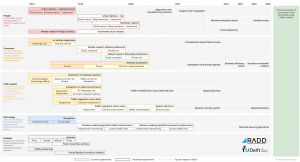Transition Path
What is the planned research transition path of RADD for 2025?
Research on Automated Driving in 2025
Click on the image to enlarge it.
The Ministry of Infrastructure and Water Management has expressed a coherent set of aims for the year of 2030. Projected on automated driving, the intentions apply as ‘an optimal network of connected cities providing a safe traffic system’. RADD aims to put fundamental research on AV-systems into realistic test settings. The 2030 aims of the Ministery of I&WM are an inspiration for RADD’s 2025 future vision in automated driving research.
A node of excellent connections. By air, road, rail, water and the internet. With maximal service to all its users, reliable, safe, emission-free, low noise and energy neutral.
A country with smart cities. With good roads and public transport, sufficient green areas and water. (…) An inspiring example of space to work, live and recreate. (…) to ensure the Netherlands as safe, livable and reachable.
In an automated traffic system communication between the vehicle and its infrastructure is key. Current research on communicative infrastructure elements such as interactive geographical maps and virtual trajectories contribute to the development of responsive navigation of individual vehicles. Artificial intelligence development in the form of decision-making algorithms and machine-learning techniques is a step towards autonomous driving.
Passive automated vehicle usage offers large advantage to customers in freight transportation. Delivery by an automated service provides flexibility and accuracy for both the recipient as well as logistic companies behind the service. Small-scale research is to be scaled throughout the entire supply chain, integrating maritime transport and aviation up to worldwide level.
Regardless of technical features of an automated driving system, the success is largely dependent of the attitude towards the service by the projected users. Both the comfort of passengers and the conditions of freight transported in automated vehicles, as well as the frequency and movement patterns from AV-service usage give valuable information on the implementation success chances. Market research as such defines design requirements for automated vehicles, the system as a whole and AV-services.
The introduction of innovative vehicle types in daily traffic evokes a certain reaction within surrounding traffic. Also the confrontation with inactive or absent car drivers is studied in terms of traffic behaviour of pedestrians and bicyclists, as well as on highways. A safe and efficient traffic system is the ultimate goal to be reached with a fully automated fleet. Autonomous driving needs a shift from reacting towards controlling traffic in order to be feasible and successful.
Innovation trajectory
To realise automated driving projects on the road, the Province of Zuid-Holland has introduced Field Labs. In these regions tests and research can be performed to support development of innovative technologies. RADD serves as a catalyst between theoretical research and laboratory testing performed at TU Delft and field research opportunities, in order to prepare for a market ready automated driving traffic system.

Research Application
Would you like to be part of the transition towards the use of automated vehicles? Please contact us or fill in our online application form.
Online Application for Research FacilitiesIN THE MEDIA
- THE GREEN VILLAGE: AN INNOVATIVE TESTING GROUND Published in: Cobouw
- THE NETHERLANDS ‘BEST PREPARED’ FOR AUTONOMOUS CARS, CYCLISTS MAKE ARRIVAL DIFFICULT Published in: NOS
- SENSOR USE WITH AUTONOMOUS VEHICLES Published in: De Volkskrant
- COMEDIAN PIETER JOUKE SEES POSSIBILITIES Published in: delft.nl
- RIJKSOVERHEID.NL: SPEECH BY MINISTER SCHULTZ VAN HAEGEN AT THE OPENING OF THE SMART MOBILITY RESEARCH LAB Published in: Rijksoverheid.nl
NEWS
- VR and Field Study to analyse interaction between pedestrians and autonomous vehicles Published on: Friday 22 February 2019
- Folluw up research car sickness Published on: Wednesday 19 December 2018
- Wanted: Research Opportunity at RADD Published on: Wednesday 07 February 2018
- Bikesim Published on: Monday 23 October 2017
- Opening of Researchlab Automated Driving Delft Published on: Saturday 24 June 2017

